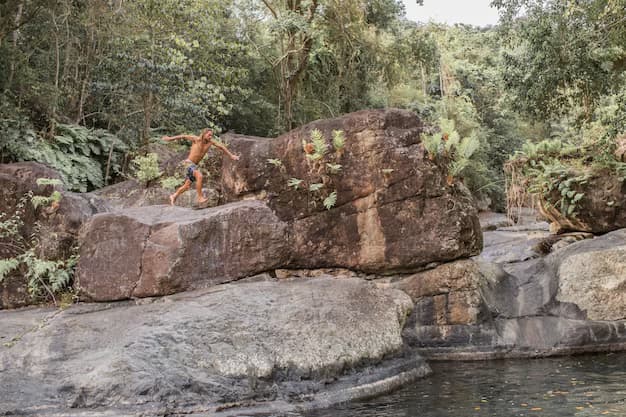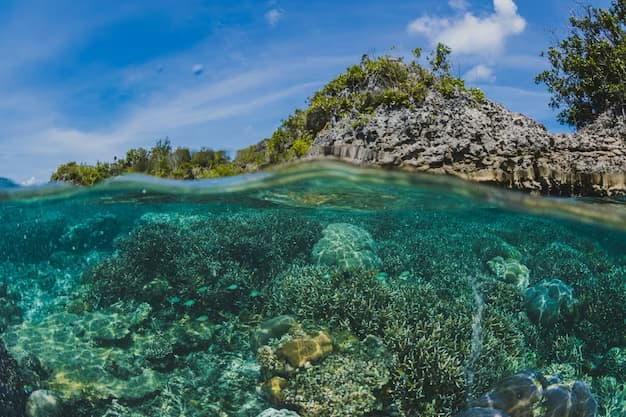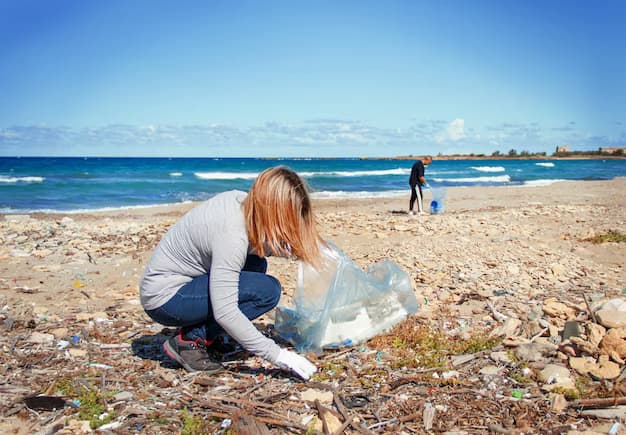Our planet is nearly inconceivably old. Circling the sun for over 4.5 billion years, our life-supporting rock has seen changes that we can only glimpse from what was left behind. Meteor showers, ice ages, and various climate conditions have led to the rise and fall of massive ecosystems and species – One of these is the Chazy Reef, which is referred to as the oldest reef on planet Earth. Although this glimpse into the past is no longer living, it is no less captivating than any of the oldest living reefs on Earth. We are all curious about how the world developed, so come with me to explore this 450 million-year-old fossil reef.
What is the Location and Geological Formation of the Area?
The Remarkable Landscape of Vermont
Nestled in the outstandingly beautiful landscape of Vermont, United States, the Chazy Reef spans across three of the Champlain islands. The location is a testament to the enduring beauty and geological significance of the area. The Chazy Reef is located in Champlain Lake, Vermont, showcasing the enduring legacy of ancient marine life in an area now known for its natural splendor.
Geological Formation and Ancient Origins
Beginning its journey approximately 450 million years ago during the Ordovician Period, reef-building organisms, primarily bryozoa, slowly left limestone deposits behind. Although they are reef-building organisms and often confused with coral reefs, bryozoa are more complex, older, and closely related to sponges. Making their home in what was the Iapetus Ocean, the reef eventually spread from Tennessee to Quebec and Newfoundland before conditions changed, and it was no longer able to thrive. The slow but steady process of limestone deposition over millions of years has resulted in the remarkable fossilized structure we see today.
Geological Timeline of Chazy Reef
| Geological Period | Events |
|---|---|
| Ordovician | Formation of Chazy Reef begins |
| Silurian | Expansion of Chazy Reef across the Iapetus Ocean |
| Devonian | Decline of Chazy Reef due to changing conditions |
Ecology
Ancient Ecosystems and Marine Life
The Chazy Reef provides a unique window into ancient marine ecosystems. During its prime, the reef was teeming with diverse marine life, including brachiopods, trilobites, and other invertebrates. These creatures formed a complex web of interactions, shaping the ecology of the time and leaving behind a rich fossil record that scientists continue to study and marvel at.
Environmental Significance and Modern Relevance
Studying the ancient ecology of the Chazy Reef offers valuable insights into the environmental conditions of the past. By understanding the dynamics of this ancient ecosystem, researchers can gain a deeper understanding of how marine life responded to changing environmental factors. This knowledge has implications for modern marine conservation efforts and provides a historical context for understanding the impact of human activities on marine ecosystems.
Key Species Found in Chazy Reef Fossils
- Bryozoa;
- Brachiopods;
- Trilobites;
- Invertebrates.
Fossil Diversity and Past Life
Preservation of Ancient Life Forms
The fossil record of the Chazy Reef is a treasure trove of ancient life forms. The remarkably preserved fossils offer a detailed glimpse into the biodiversity of the Ordovician Period, showcasing the intricate structures and delicate features of long-extinct organisms. These fossils provide invaluable information for paleontologists and biologists seeking to reconstruct the evolutionary history of marine life on Earth.
Unique Fossil Discoveries
Among the most striking fossil discoveries in the Chazy Reef are the exceptionally well-preserved trilobite specimens. These ancient arthropods, with their distinctive segmented bodies and calcified exoskeletons, provide a wealth of information about the morphology and behavior of these ancient creatures. Such discoveries contribute significantly to our understanding of prehistoric marine ecosystems and the evolutionary pathways of marine organisms.
Fossil Diversity in Chazy Reef
| Fossil Type | Description |
|---|---|
| Trilobites | Well-preserved arthropod fossils |
| Brachiopods | Fossilized shells of ancient organisms |
| Bryozoa | Intricate fossilized colonial organisms |
Chazy Reef’s Ecological Evolution Over Time
Changing Environmental Conditions
Over the course of millions of years, the Chazy Reef witnessed significant changes in environmental conditions. From its initial formation in the Ordovician Period to its decline in the Devonian, the reef responded to shifting oceanic currents, sea levels, and climatic variations. These changes shaped the ecological dynamics of the reef, influencing the distribution of species and the overall structure of the ancient ecosystem.
Adaptation and Resilience
Despite the challenges posed by changing environmental conditions, the organisms inhabiting the Chazy Reef demonstrated remarkable resilience and adaptability. Through periods of environmental upheaval, these ancient marine life forms persisted and evolved, leaving behind a legacy of biological innovation and ecological success. Understanding the adaptive strategies of these ancient organisms provides valuable insights into the dynamics of long-term ecological change.
Factors Influencing Ecological Evolution
- Climate fluctuations;
- Sea level changes;
- Oceanic currents.

What Led to the Demise of Chazy Reef?
Environmental Shifts and Extinction
As the environmental conditions continued to change, the once-thriving Chazy Reef faced insurmountable challenges. Shifts in oceanic chemistry, temperature, and habitat availability ultimately led to the decline and eventual extinction of the reef-building organisms. The demise of the Chazy Reef serves as a poignant reminder of the vulnerability of ecosystems to environmental perturbations and the profound impact of long-term environmental change on the stability of marine habitats.
Legacy of Extinction
While the Chazy Reef may no longer exist as a living ecosystem, its legacy endures in the form of fossilized remnants and scientific discoveries. The extinction of the reef represents a critical juncture in the ecological history of our planet, offering important lessons about the interconnectedness of environmental factors and the fragility of marine ecosystems in the face of global change.
Factors Contributing to Chazy Reef Extinction
| Environmental Factor | Impact on Chazy Reef |
|---|---|
| Oceanic chemistry changes | Decline in reef-building organisms |
| Temperature fluctuations | Disruption of ecological balance |
| Habitat loss | Reduction in suitable reef conditions |
Chazy Reef as a National Natural Landmark
Recognition and Conservation Status
In recognition of its exceptional geological and paleontological significance, the Chazy Reef has been designated as a National Natural Landmark. This prestigious status reflects the importance of preserving and studying this ancient fossil reef, ensuring that future generations can continue to learn from its remarkable legacy. The conservation efforts aimed at protecting the Chazy Reef underscore the value of safeguarding our planet’s geological heritage.
Educational and Scientific Value
The designation of the Chazy Reef as a National Natural Landmark not only highlights its geological importance but also emphasizes its role as a site of scientific inquiry and public education. By promoting research and educational initiatives centered around the Chazy Reef, conservation efforts contribute to a greater understanding of Earth’s ancient history and the processes that have shaped our planet over millions of years.
Conservation Initiatives for Chazy Reef
- Research programs focused on fossil preservation;
- Public outreach and educational programs;
- Geological site management and protection measures.
Future Challenges and Opportunities: Sustaining Chazy Reef
Conservation Imperatives
As we look to the future, the sustained preservation of the Chazy Reef presents both challenges and opportunities. Climate change, habitat degradation, and human activities pose ongoing threats to the integrity of this ancient fossil reef. Addressing these challenges requires a concerted effort to implement effective conservation measures and promote sustainable land use practices in the surrounding areas.
Scientific Exploration and Discovery
The ongoing study of the Chazy Reef offers boundless opportunities for scientific exploration and discovery. By leveraging advanced technologies and interdisciplinary research approaches, scientists can unlock new insights into the ecological evolution of ancient reefs and the broader implications for understanding Earth’s geological history. Continued scientific engagement with the Chazy Reef holds the potential to yield groundbreaking discoveries and expand our knowledge of prehistoric marine ecosystems.
Future Prospects for Chazy Reef Conservation
| Challenge | Conservation Opportunity |
|---|---|
| Climate change impacts | Implementing adaptive management strategies |
| Habitat restoration efforts | Enhancing ecological resilience of the fossil reef |
| Sustainable tourism practices | Balancing conservation with public access |
Conclusion
In conclusion, the Chazy Reef stands as a testament to the enduring legacy of ancient marine life and the profound geological forces that have shaped our planet over millions of years. From its humble beginnings in the Ordovician Period to its designation as a National Natural Landmark, the Chazy Reef continues to captivate and inspire scientists, conservationists, and enthusiasts alike. As we strive to sustain and protect this remarkable fossil reef, we honor the invaluable insights it offers into Earth’s ancient history and the interconnectedness of life and the environment. The Chazy Reef remains a timeless symbol of the enduring wonders of our planet, inviting us to explore, learn, and preserve the extraordinary treasures of our natural world.



